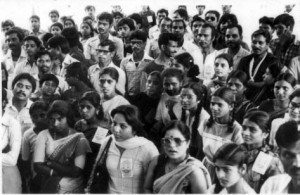 GOVERNMENT
OF INDIA
GOVERNMENT
OF INDIA
 GOVERNMENT
OF INDIA
GOVERNMENT
OF INDIA
 As per National Data Sharing and Accessibility Policy (NDSAP) initiated by Central Government of India every Ministry / Department can share their valuable datasets / Information on Open Government Data (OGD) Platform India i.e. https://data.gov.in. As on 18th June 2015, there are 106 catalogs which include 3645 number of valuable resources shared by “Registrar General and Census Commissioner of India” indicating different indicators at various levels like All India, States/ UTs, District, Taluk, Village/ Town etc.
As per National Data Sharing and Accessibility Policy (NDSAP) initiated by Central Government of India every Ministry / Department can share their valuable datasets / Information on Open Government Data (OGD) Platform India i.e. https://data.gov.in. As on 18th June 2015, there are 106 catalogs which include 3645 number of valuable resources shared by “Registrar General and Census Commissioner of India” indicating different indicators at various levels like All India, States/ UTs, District, Taluk, Village/ Town etc.
Please have a look on the given link to visualize the Census of India Catalogs and Datasets on Open Data Format i.e. https://data.gov.in/catalogs/ministry_department/ministry-home-affairs/s…. And also there are some important catalogs named ‘Population in single year age by Residence and Sex – India and States’, ‘Complete Towns Directory by India/State/District/Sub-District Level – Census 2011’, ‘Complete Villages Directory by India/State/District/Sub-District Level – Census 2011’ etc. which provides information / data regarding ‘Gender and single year age wise District/ State/ UT level population in India’, ‘Town names with their complete hierarchy of Sub-District, District, State/ UT names in India’ and ‘Village names with their complete hierarchy of Sub-District, District, State/ UT names in India’ respectively.
The Reserve Bank of India represents India’s monetary policy. In the same way The Census of India represents India’s central bank for social policy. The Census of India is the most credible source of information on Demography (Population characteristics), Economic Activity, Literacy and Education, Housing & Household Amenities, Urbanisation, Fertility and Mortality, Scheduled Castes and Scheduled Tribes, Language, Religion, Migration, Disability and many other socio-cultural and demographic data since 1872. This is the only source of primary data in the village, town and ward level, which provides valuable information for planning and formulation policies for Central and the State Governments and is widely used by National and International Agencies, Scholars, business people, industrialists, and many more.
At National level we can map each individual with Aadhaar card (UIDAI) which will help in avoiding duplication and other glitches. With this, there are certain entities such as public sector banks, insurance companies, state governments and welfare programmes which can utilize this module enabling levels of benefits to them which will outstrip their costs incurred.
As it provides data at the lowest level, user friendly multidimensional applications can be made using the same and a layman (a person without having specialized knowledge in a particular subject) can easily operate that application as per his prospective requirement. For example, an application can be made showing/ visualising Map of various locations and the information would be reliable as it is shared by Indian Government Ministry.
Business people can run their business smoothly by looking into the Open data of Census (Demography, Religion, Literacy and Education etc.) like what is the living standard or income level of the people in that particular area.
India ranks number 2 in the list of countries by population in world having more than 1.2 billion people. Our population is an asset for our growing country. A big manpower is a blessing for country. Population can be used as an asset if we have a proper planning. Since our childhood, we were told that the population was not an asset for our country. But today it is exactly the opposite of that, and India has an advantage of its young population now. We can use our population as an asset by planning a good system of classification and sending people to various fields, as per their qualifications and interest areas. We need to provide better education system to them, so that we would produce good human resource. We are producing so many professionals every year. There are so many people in India having different skills / expertise. There are a mass of people are unemployed and unskilled. If those unskilled people can be brought to work depending on their qualification and capabilities, then this system of unemployment will finish. It will helpful to add something more to the already rising growth rate towards GDP of our Indian economy.
Therefore, in order to cater to this asset which is population it is imperative that we get specific micro level data of the population in hand so that they can be effectively utilised to contribute to India’s growth story. Registrar General of India with its census data is a huge repository of information and datasets which can add value to the growth story of India. This data when integrated with datasets and information from other credible sources, namely UID will provide us characteristic datasets which is unparalleled in nature enabling us to analyse trends and simulate situations which can provide us with much needed information to enhance public service delivery and promote evidence based decision making.
Total Comments - 0